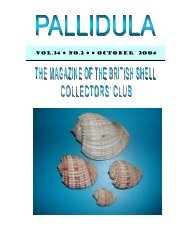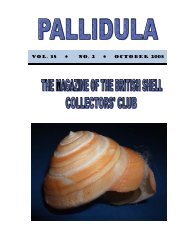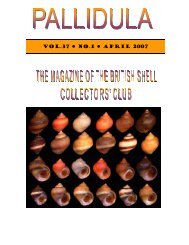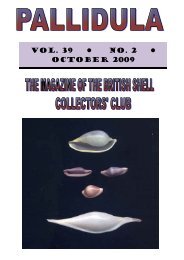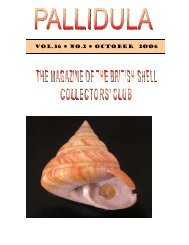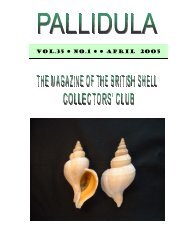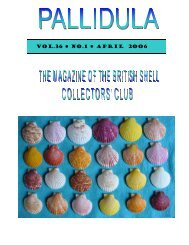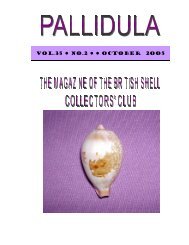April, 2004 - British Shell Collectors' Club
April, 2004 - British Shell Collectors' Club
April, 2004 - British Shell Collectors' Club
Create successful ePaper yourself
Turn your PDF publications into a flip-book with our unique Google optimized e-Paper software.
ISSN 0140-2471•VOL.34•NO.1•APRIL <strong>2004</strong>
Page 2PALLIDULACOVER PAGEA wonderful pair of Buccinum undatum Linne 1758 from the collection of Derek Howlett, showing a typicaldextral specimen as well as a very rare sinistral specimen, both trawled off Wells, Norfolk by commercialfishermen.
PALLIDULA Page 3SYMBIOSISBY JOHN FISHERI am sure that all of us who have engaged in beachcombing on our Western coastline have found thedead shells of Turritella communis Risso.1826. But how often do we come across any livespecimens? It is said to be a mud dweller and are usually found partially buried.During my recent collecting trip to County Galway in Ireland I visited Carraroe. This is a coral strandwhere many interesting species are washed ashore. However I was very surprised to find a largenumber of live Turritella but what was even more surprising was that every one of them had longstrands of a “ ribbon” seaweed attached to them as illustrated in the photograph. What is more theseaweed was always attached to the outer apertural lip. This must be some kind of symbiotic lifestylewhich I have never come across before. Has anybody any ideas?The beach at Carraroe
Page 4PALLIDULAThe Molluscs of Dogs BayBy John Fisher.Dogs Bay is a small secluded sandy inlet on the Roundstone peninsula in County Galway onthe west coast of Ireland. It is bordered on each side by rocky outcrops and faces the openAtlantic Ocean. It is renowned for its enormous variety of molluscs which are largely obtainedfrom the shell grit and drifts on the beach.My study has been conducted over a period of four years and has involved sorting throughover one hundredweight of grit collected at various times over this period.The beach is extremely variable, at times it is totally sandy with not a shell in sight and atothers there is nothing but shells. On the latter occasions one has to be patient sortingthrough literally millions of Rissoa parva in the hope of finding something new.When I visited Dogs Bay in <strong>April</strong> 2002 it was one of those occasions when the beach wascovered with sand and I was unable to find any shell grit at all. However on my way off thebeach I noticed a drift of black material which I presumed was disintegrated seaweed. Onclose inspection this was full of small white shells, so I collected four good sized bags andput it in the boot of the car, only to get into trouble later from Margaret when we discoveredthe bags were not watertight and the boot was saturated. But all was not lost and thecontents provided several additions to the species list. The most notable being Spiratellaretroversa, a very minute and delicate sinistral shell which I had never seen before and herethey were in very good numbers. Also the specimen of Odostomia and Brachystomia werein very good condition showing both spiral and growth lines, making identificationconsiderably easier. This was also the only occasion when I was fortunate enough to findspecimens of Pusillina sarsi, Ammonocera rota, and Aclis ascaris, presumably thesenormally get broken up by the wave action on the beach.I have been impressed by the variety of turrids recorded on nearly every visit. Thecommonest of these is Mangelia nebula which can be collected in good numbers by justwalking along the beach. Others include Haedropleura septangularis, Cytharellacoarctata,Oenopota rufa, Oenopota turricula, Raphitoma linearis, and Raphitoma purpurea.My interest in Dogs Bay is far from finished as I still have approximately 14lbs of shell gritsitting in the garage but with winter approaching it will keep me occupied on those colddreary nights.On my next visit I shall be brushing and scraping the rocks at either end of the bay in order toascertain which species live in the littoral zone and which have been washed up from deeperwater.As the beach is also an outlet to several freshwater streams the shell grit contains someinteresting land and freshwater species including Vertigo angustior, the origin of which I stillhave to locate.The following is my complete list of shells obtained to date.GASTROPODS.Diodora graeca. Linnaeus 1758Acmaea virginea Muller 1776Patella vulgata . Linnaeus 1758Helcion pellucidum. Linnaeus 1758Gibbula tumida . Montagu 1803Gibbula umbilicalis. daCosta 1778Monodonta lineata. daCosta 1778Skenea nitens Philippi 1844Skenea serpuloides. Montagu 1808Tricolia pullus. Linnaeus 1758Lacuna pallidula. daCosta 1778Rissoa lilacina. Recluz 1843Rissoa rufilabrum. Alder 1844Rissostomia membranacea. J.Adams 1800Lacuna parva. daCosta 1778Lacuna vincta. Montagu 1803Littorina neglecta. Bean 1844Littorina neritoides. Linnaeus 1758Littorina littorea. Linnaeus 1758Littorina obtusata. Linnaeus 1758Littorina saxatilis. Olivi 1792Hydrobia ulvae. Pennant 1777Rissoa parva. daCosta 1778Rissoa parva interrupta. Adams 1798Spiratella retroversa. Fleming.Philine catena. Montagu 1803.Philine punctata. Adams 1800.Cylichna cylindracea. Pennant 1777.
PALLIDULA Page 5Pusillina sarsi. Loven 1846Alvania cancellata. daCosta 1778Alvania cimicoides. Forbes 1844Alvania punctura. Montagu 1803Alvania semistriata . Montagu 1808Manzonia crassa. Kanmacher 1798Cingula trifasciata. J.Adams 1800Onoba aculeus. Gould 1841Onoba semicostata. Montagu 1803Barleeia unifasciata. Montagu 1803Barleeia unifasciata rubra. J.Adams 1797Cingulopsis fulgida. J.Adams 1797Rissoella diaphana. Alder 1848Omalogyra atomis. Philippi 1841.Ammonocera rota. Forbes & Hanley 1850Skeneopsis planorbis. Fabricus 1780.Circulus striatus. Philippi 1836.Caecum glabrum. Montagu 1803.Caecum imperforatum Kanmacher 1798.Turritella communis. Risso 1826.Bittium reticulatum. DaCosta 1778.Aporrhais pespelecani. Linnaeus 1758Lamellaria latens. Muller 1776.Velutina velutina Muller 1776.Trivia monacha. DaCosta 1778.Trivia arctica. Pulteney 1799.Lunatia alderi. Forbes 1838.Nucella lapillus. Linnaeus 1758.Ocenebra erinacea. Linnaeus 1758.Chauvetia brunnea. Donovan 1804.Nassarius incrassata. Strom 1768.Nassarius pygmaea. Lamarck 1822.Nassarius reticulata. Linnaeus 1758.Haedropleura septangularis. Montagu 1803.Oenopota rufa. Montagu 1803.Oenopota turricula. Montagu 1803.Mangelia nebula. Montagu 1803.Cytharella coarctata. Forbes 1840.Raphitoma linearis. Montagu 1803.Raphitoma purpurea. Montagu 1803.Cerithiopsis pulchella. Jeffreys 1858.Cerithiopsis tubercularis. Montagu 1803.Triphora adversa. Montagu 1803Epitonium clathratulum. Kanmacher 1798.Epitonium clathrus. Linnaeus 1758.Janthina exigua. Lamarck 1816.Aclis ascaris. Turton 1819.Cima minima. Jeffreys 1858.Graphis albida. Kanmacher 1798.Eulima bilineata. Alder 1848.Melanella alba. DaCosta 1778.Chrysallida decussata. Montagu 1803.Chrysallida indistincta. Montagu 1808.Chrysallida obtusa. Brown 1827.Evalea diaphana. Jeffreys 1848.Evalea obliqua Alder 1844.Evalea warreni. Thompson 1845.Jordaniella nivosa. Montagu 1803.Brachystoma albella. Loven 1846.Brachystoma eulimoides. Hanley 1844.Brachystoma rissoides. Hanley 1844.Odostomia plicata. Montagu 1803.Odostomia turrita. Hanley 1844.Odostomia unidentata. Montagu 1803.Ebala nitidissima. Montagu 1803.Leucophytia bidentata. Montagu 1808.Diaphana minuta. Brown 1827.Cadulus jeffreysi. Monterosato.Retusa truncatula. Bruguiere 1792.Siphonodentalium lofotense. M.Sars.Turbonilla lactea Linnaeus 1758.BIVALVES.Arca tetragona PoliAnomia ephippium. Linnaeus 1758.Heteranomia squamula. Linnaeus 1758.Monia squama. Gmelin 1791.Monia patelliformis. Linnaeus 1758.Modiolus phaseolinus. Philippi 1844.Mytilus edulis. Linnaeus.1758.Chlamys varia. Linnaeus.1758.Chlamys opercularis. Linnaeus.1758.Lima loscombi. Sowerby 1841.Lima subauriculata. Montagu 1803.Lucinoma borealis. Linnaeus 1758.Thyasira flexuosa. Montagu 1803Kellia suborbicularis. Montagu 1803.Lasaea rubra. Montagu 1803.Neolepton sulcatulum. Jeffreys 1865..Montacuta ferruginosa. Montagu 1803.Mysella bidentata. Montagu 1803.Parvicardium exiguum. Gmelin 1791..Parvicardium scabrum. Philippi 1844Cerastoderma edule. Linnaeus.1758.Timoclea ovata. Pennant 1777.Chamelea striatula. daCosta 1778.Clausinella fasciata. daCosta 1778..Venerupis pullastra. Montagu 1803.Irus irus. Linnaeus 1758.Turtonia minuta. Fabricius 1780.Mactra corallina. Linnaeus 1758.Spisula subtruncata. daCosta 1778.Donax vittatus. daCosta 1778Tellina tenuis. daCosta 1778..Tellina fabula. Gmelin 1791.Tellina pygmaea. Loven .Gari tellinella. Lamarck 1822.Ensis arcuatus. Jeffreys 1865.Mya truncata. Linnaeus 1758.Hiatella arctica. Linnaeus 1758.Dogs Bay, Co.Galway, Ireland
Page 6PALLIDULACOMMON WHELK SHELLS IN THE NORFOLK BROADSBY DEREK HOWLETTDuring the early summer of 2003 when I was at one of the Broads Authority depots, I was handed abag containing 14 shells of the Common whelk (Buccinum undatum, L.) by a member of staff there.When asked where he obtained them from, he replied, from a drainage dyke on the marshes at HowHill, Ludham (Map Ref. TG 374 190). Chatting further with him revealed that dyke clearance anddigging work had been going on at How Hill and the shells had been found on one of the clay spoilheaps. These shells were obviously fossil. It is no secret that the Norfolk Broads were at one timeunderneath the North Sea, but it is nice occasionally to see the proof of this.Later on at home I decided to clean up the shells for easier examination. Imagine my surprise when Ifound the operculum present in the dried clay inside five of the shells. This posed the question “Howdid these Whelks die?” Was it receding sea levels?I assumed this to be the case but, surely it would take a long time, plenty of time, in fact for theoperculum to become separated from the shell, I would have thought. Up to now I have never everfound a beached gastropod complete with the operculum inside.Most of these shells are in remarkable condition, some still with polychaete worm tubes in place. Allare quite a small size for the species, the largest measuring only 66mm, and the smallest 39mm.Perhaps they could be ancestors of the form B. littoralis, King which is smaller than the deep waterforms.If any member would like one of these shells please give me a ring. At the moment I have 10specimens left. Also if anyone has any theories or information on this subject please let me or theEditor know. As this would be a useful note for a future edition of Pallidula.
PALLIDULA Page 7SHELLING IN NEW CALEDONIABY JOHN BATTIn early September 2003 we set off on our long awaited trip to what many people call the end of theearth, the beautiful subtropical island of Grande Terre, New Caledonia.Both my wife and I along with my parents arrived in Sydney, Australia some twenty hours after ourdeparture from Heathrow, including a one hour stop in Singapore for refuelling. We had decided tostay and recover in Sydney for five days with my wife’s cousin who lives near Bondi. He was morethan happy to act as our guide and show us the usual tourist sites in and around the city. On our firstday we decided to visit the Opera House, Botanical gardens and Sydney harbour bridge and over thefollowing four days visited the Koala Park, Blue Mountains, Sydney Aquarium, and took a boat triparound the harbour. We searched Sydney high and low for shell shops but never came across any. Idid have the address of one but when we eventually found the place it had closed down. On our lastnight we had dinner in the restaurant at the top of the sky tower to try such delicacies as Kangaroo,Emu and Camel, and then returned to Bondi to pack for our onward flight the next morning to NewCaledonia.Our flight with Air Calin departed from Sydney at 11am and we arrived at our hotel, the KuenduBeach Resort at 3pm. The Resort is about ten minutes drive from the capital Noumea and about onehour from Tontouta international airport. New Caledonia is a French Pacific territory in Melanesia.The main island of Grande Terre is the fourth largest island in the south pacific after New Guinea andthe north and south islands of New Zealand. It is about 400km in length and 50km in width and issurrounded by the second largest barrier reef in the world after Queensland’s Great Barrier Reef, butNew Caledonia’s lagoon is the worlds largest.We stayed in a traditional palm thatched pillared bungalow with all of the necessary self cateringfacilities and colour TV. I awoke at about 6 am on our first morning and was far to excited to wait forGoga (the wife) to get up, so I slipped off down to the beach to see what I could find. The sea wasquite choppy and had washed up many Bluebottle jellyfish, along with hundreds of Spirula spirulaL.1758 and as many Janthina janthina L.1758 as you could wish to collect, still alive with the bubblesacks attached. I found a live Ficus subintermedia Orbigny 1852, a couple of Strombus mutabilisSwainson 1821 and picked my way through hundreds of beached bivalves, most with both valves andmany in good condition. After a couple of hours I returned to our bungalow to freeze the livespecimens and get myself ready for our morning trip to Noumea .The main reef off Noumea Kuendu Resort Highly venomous seasnakeLaticauda colubrinaAs a cowry collector my main interest in visiting New Caledonia was to collect melanistic and rostratecowries (I will refer to these as M&R in the text). Many of the 44 known species to be found M&R canbe collected in shallow water so I hoped that I would get lucky and find some on this trip. Realisingthe rarity of these shells I knew I would have to purchase the majority from the various dealers andshops in the city.
Page 8PALLIDULAOn our way to Noumea I spotted a shop called Caldoshell Creations but was unable to stop as wewere on the hotel shuttle bus, but I knew that once we had our hire car we would be free to do as weplease.On arrival in Noumea we changed up some money and set off in search of some new specimens formy collection. We headed straight for the market at Port Moselle and found many stalls selling nativecrafts and an amazing fish market with some of the strangest looking fish I had ever seen. Luckilythere was a stall selling specimen shells and they had a lovely assortment of M&R cowries includingsome splendid specimens of Leporicypraea mappa viridis “montrouzieri” Dautz1903, they werehowever a bit top heavy in the price department so I thought I would hold on and see what else I canfind around Noumea. Walking back from the market we spotted a shop called Ocean Distributorsand this is where I purchased the cowries pictured bellow.Mauritia arabica arabica Left: Erronea caurica caurica Left: Bistolida hirundo rouxi(M&R) - L. 1758 (M&R) - L.1758 (M&R) Ancey 1882Right: Lyncina lynx (R) -L.1758 Right: Erosaria annulus (R)L.1758From here we went to pick up our hire car to return to Kuendu for an afternoon on the beach. After agreat day we decided to go for an evening meal in the hotel restaurant followed by a win for meagainst my mother in the all new South Pacific scrabble championships – there is not much to do inthe evenings at Kuendu!We decided that a trip to Prony Bay on the southern tip of Grande Terre will make for a great secondday in N. Caledonia, so we packed some food and drink along with my snorkelling gear and set off forthe south. As soon as we left Noumea we noticed very little in the way of civilisation, just a fewsmall villages containing a handful of houses and the further we drove south the more the roadsdeteriorated, especially through the mountains. Wewere told not to venture south if rain was forecast as inN. Caledonia they have depressions in the roads forrivers to run through instead of bridges over them so it’seasy to get cut off. We must have looked a picture inour tiny Renault Clio rattling over six inch potholes andcovered in red dust. We eventually arrived at Prony andfound ourselves too far up the river and the only shellswe could find were Cerithiums. Looking at the map itwould take us too long driving back inland to reach theother side which is more easily accessible from Goroand Port Boise. It turned out to be one of those daysthat nothing was going to go right. We realised today thatProny Baysouthern N. Caledonia is a difficult place to get around but it was a lesson that we needed to learn.We thought that it would be nice to stay around the Noumea area on our third day, so we decided tocheck out Magenta beach, as I remember reading an article in the past relating to collecting M&Rcowries there at low tide. The beach is right at the end of Magenta airport runway and is a muddybay where the tide goes out quite a long way. I waded through water about 12 inch deep at low tideand found many specimens of Strombus gibberulus gibbosus, Roding 1798 with very dark brownbanding, live crawling over the muddy sand totally exposed along with a beautiful live specimen of
PALLIDULA Page 9Phos senticosus L.1758. I headed towards the rocks and dead coral towards the right hand side ofthe bay and found Erronea errones “caerulescens” Schroter 1804 and Erosaria moneta L.1758 underjust about every rock or slab that I turned over but no luck with M&R specimens. I was lead tobelieve before the trip that the M&R cowries are very rare these days and that the majority werecollected throughout the 1970’s and 1980’s but are still collected from time to time these days.On our way back from Magenta we stopped at Caldoshell Creations, the shop that I noticed on ourfirst day on the bus to Noumea and my luck was about to change. I introduced myself to the owner,who luckily spoke good English and I explained that I was looking for M&R cowries. He replied that hedoes not trade in them any more due to their expense but he does have a large number of other N.Caledonian Cypraeidae. He had a magnificent selection of Erronea subviridis subviridis Reeve 1845so I picked out a large 36mm specimen and a small almost albinotic specimen as well as four superbErronea bregeriana Crosse 1868, one at a whopping 31mm, an unusual small pale specimen and twovery dark pieces. We were very lucky to buy a fantastic pair of rare deep water main reef forms ofLeporicypraea mappa viridis Kenyon 1902. All pictured below.Erronea subviridis subviridis Erronea bregeriana Leporicypraea mappa viridis Kenyon 1902Reeve 1845 Crosse 1868These map cowries differ from typical mappa viridis being far more callous around the margins andextending further at the canals, as well as lacking the usual prominent basal blotch, they are veryheavy for viridis and may well deserve a separate name at form level. I would like to propose thename L. mappa viridis “kanakinus” but I will have to speak to Mr Lorenz about this one. Along withthese acquisitions I also purchased a large Leporicypraea mappa viridis “montrouzieri” Dautz 1903with a very wide open map pattern, a Strombus thersites Swainson 1823, Bistolida stolida crosseiMarie 1869 and several specimens of Nautilus macromphalus Sow. 1849.The owner of the shop mentioned that he had a friend who was the Treasurer of N. Caledonia’s <strong>Shell</strong><strong>Club</strong> that published the Rossiniana magazines – now finished, and that he had a marvellouscollection of M&R cowries. He arranged for me to meet Mr Gille Naveau the following morning andfrom the shop we headed for his home to view the collection. Although Mr Naveau had given upcollecting some time ago he still had an impressive collection and did not mind selling specimensfrom it.John Batt and Gille Naveau Some of Mr Naveau’s collection The best of Mr Naveau’s mappasI was really taken by the map cowry pictured above although I thought the $7.500.00 price tag was alittle bit out of reach at this time, however, I did purchased the slightly less dark but still impressivespecimen pictured on the following page. I also purchased the pair of Cribrarula cribraria cribrariaL.1758, an exceptionally dark Mauritia arabica arabica L.1758 and a small but very rostrate Bistolidahirundo rouxi Ancey 1882. I asked Mr Naveau if he thought it was still possible to collect M&Rcowries around the Noumea area, but he said probably not, you will have to travel south to Gorowhere you should look for the old, now derelict mine where there is a large metal structure jutting out
Page 10PALLIDULAinto the bay on large concrete pillars. It was an old conveyor for loading nickel onto ships when themines were operational. He said that he had collected arabica, mauritiana, eglantina and pallidula inthis area.Mauritia arabica arabica Cribrarula cribraria cribraria Bistolida hirundo rouxi Leporicypraea mappaL.1758 L.1758 Ancey 1882 viridis “montrouzieri”Dautz 1903We thanked Mr Naveau for his hospitality and headed off to one of Noumea’s beaches for theremainder of the day, and to catch low tide. With nothing very interesting found this afternoon wedecided on day five to take the taxi boat to Canard Island and spend the day snorkelling on the reef,but we found out that in March a powerful hurricane hit Noumea and it seemed to have largelydamaged the reef and huge piles of dead staghorn coral were piled up everywhere. At low tide wewalked out to the edge of the reef dodging the numerous sea snakes to turn some dead coral slabs.I found the usual common species like Erosaria annulus L.1758, Erosaria moneta L.1758 and acouple of Erosaria caputserpentis caputserpentis L.1758, when Goga shouted for me to come andlook at something. She had found a live specimen of Lyncina leviathan titan Sch.& Sch. 1962crawling amongst the dead staghorn coral, the first and only one of the trip. Another day had passedwith no sign of self collecting any M&R cowries, so we decided that we would rise early the followingmorning and head for Goro bay in the south to check out the area around the old nickel mine.It took us about three hours to reach Goro crossing the mountains towards the village of Yate on theeast coast and following the coast road down to Goro bay over some very bumpy dusty tracks. Thiswas certainly not a place to be visited by people who suffer from arachnophobia. All along the roadfrom ground level up to the telegraph wires were huge spider webs and it was not long before wenoticed one of the residents, a huge Orb spider the size of the palm of my hand with a massive brightgreen abdomen amongst other black and white specimens dotted about everywhere. I could nothelp but prod big “greenie” with a stick to get him to show us his fangs – awesome! We then crossedthe road onto the beach in search of some shells. There was no evidence of shells washed up onthe beach so I headed for the piles of large rocks built up against one of the huge concrete columnsholding up the conveyor. The water here was about 18 inches in depth and the same orange colouras the beach, a mixture of metallic elements like nickel, cobalt, manganese and iron. It certainlyseemed a likely place to find M&R cowries so I began to turn some of the rocks. I immediately founda sub adult Mauritia mauritiana L.1758 which I left under its rock and then my first specimen ofMauritia arabica arabica L.1758 not melanistic but still very dark and in perfect condition.Throughout the next two hours of low tide I found fifteen specimens of arabica but only kept four ofthem, all variations in pattern and size. As the tide began to turn I hurried franticly looking for at leastone melanistic specimen, crawling on my hands and knees peering into the crevices of rocks thatwere too large to move. I noticed a cowry deep in between two large boulders so I reached in andgrabbed the shell. To my great surprise it was a melanistic Mauritia mauritiana L.1758, about 85%black and a perfect flawless mature adult. I could not believe what I had just found. I had boughtquite a few M&R cowries back in Noumea from the shops but to find one myself was a far greaterpleasure. We could not help but wonder how many more we could have collected given more time inGoro but happy with my finds it was time to start heading back to Noumea before dark, as we hadbeen warned of how dangerous it is to drive through the mountains at night due to stray animals onthe roads and a lack of crash barriers on the corners.
PALLIDULA Page 11A live Mauritia arabica arabica Goro Bay Orb spider Self collected MelanisticL.1758 Mauritia mauritianaL.1758The following morning, day seven, I woke early to defrost my cowries from Goro but was unable toextract the slugs so they needed to be re-frozen. We then headed into Noumea for a day of souvenirshopping and to hand back our hire car. Just along from the hire car centre we noticed a shop calledLa Bougainville with a selection of shells in the window so in we went to find a wonderfulassortment of N. Caledonian cowries. I purchased a spectacular main reef orange form of Cypraeatigris L.1758 very rare these days, and the largest specimen of M&R Bistolida stolida crossei Marie1869 that I ever recall seeing at a huge 49.1mm along with four smaller specimens of stolida, threerostrate Erosaria moneta L.1758 and a M&R Erronea cylindrica lenella Iredale 1939. It turned out tobe a fruitful day all be it a costly one, so we returned to Kuenduresort to relax on the beach for the remaining hours of daylight.At Kuendu beach I got chatting to Tarawake, who owns the diveshop there and the company that runs boat trips to some of theuninhabited islands offshore. He and his partner Anabellainvited us on our last day to sail to a small un-named island sixmiles offshore for a day of snorkelling, water sports and a beachbarbeque.We had a fabulous day on the island with a superb barbequeand some great snorkelling. I did find a pretty specimen of Cypraea tigris (orange form), L.1758Lambis lambis L.1758 with a bright orange aperture buried in thesand at about three feet but that was about all I found in the wayof shells worth keeping.We thoroughly enjoyed our visit to Grande Terre and I am surethat N. Caledonia has so much more to offer, especially forthose able to dive. I will definitely return and hopefully spend alot more time around the Goro area in search of more melanisticand rostrate cowries.Its on to Fiji and the island of Viti Levu for us now but I will usethis as a separate article in the next issue of Pallidula Bistolida stolida crossei Marie 1869Left 33mm, right 49.1mmTypical beach at Goro Un-named island we visited Arial view of an island onon our last daythe main barrier reef
Page 12PALLIDULA<strong>Shell</strong>ing in Cumbria October 2003By Selina WilkinsI was sent on business to Barrow in Furness, and was delighted to find it marked on the map withgolden sands. I booked into a delightful small hotel that is also a pub, with excellent breakfast andevening meals called Clarke’s Hotel, at Rampside. Although on arrival it was raining, I put on myraincoat and ambled down to the beach, it might never have stopped raining. On first perusal Idiscovered hoards of cockles, Cerastoderma edule, and beautiful Macoma balthica. The Macomabalthica were pink, dark pink, pale pink, yellow, cream, white, peach and all with both valvespreserved and intact. They were mostly juveniles, but to have them intact, with such colour variation– I was very happy. I was also pleased to find a few Turritella communis, as the beaches I go torarely have them, and I also found one specimen of a little un-yet identified gastropod.At Whaley Island I found nothing at the beach, but it was raining, and I didn’t have a pair of wellies toinvestigate slippery stones and seaweed. So I chose on my remaining days to concentrate onFoulney Island and Rampside Beach.For the next three days after work I explored the area. Rampside Beach was very good for beachedspecimens of bivalves and gastropods, especially the Macoma balthica and Littorina genus. To thefar right of the beach there was an area of rocks with more gastropods and the Mytilis edulis and theoysters.Foulney Island was a lovely walk out along a causeway. This is where the beached gastropods andMytilis edulis mainly came from. Beyond the cement block on the right hand side (as recommendedfor baiters) there were stones strewn with seaweed. Littorina obtusata could be found movingamongst the seaweed, and the Mytilis edulis was between the rocks and stones. The Nucella lapilluspreferred the exposed rocks and stones, and Littorina littorea and saxitilis could be found whereverthere was moisture, but also in the seaweed.It was a very picturesque place and those of you into bird watching as well would have appreciatedthe oystercatchers, redshank, sanderlings, dunlins, curlews and whimbrels, various gull species. Inthe summer there are nesting eiders, sandwich and little terns as well as common terns. It might notseem a shelling Mecca to some of you, but I found the place delightful, relaxing and the food atClarke’s hotel was wonderful (the Moules marniere come all the way from Chile!)Rampside BeachFoulney IslandCerastoderma edule Linnaeus, 1758 Littorina littorea Linnaeus, 1758Ostrea edulis Linnaeus, 1758 Mytilis edulis Linnaeus, 1758Crassostrea virginica Gmelin, 1791 Nucella lapillus Linnaeus, 1758Mytilis edulis Linnaeus, 1758 Littorina obtusata Linnaeus, 1758Macoma balthica Linnaeus, 1758 Buccinum undatum Linnaeus, 1758Littorina obtusata Linnaeus, 1758Littorina saxatilis Olivi, 1792Littorina littorea Linnaeus, 1758Ocenebra erinacea Linnaeus, 1758Turritella communis Linnaeus, 1758Nucella lapillus Linnaeus, 1758Chlamys varia Linnaeus, 1758Buccinum undatum Linnaeus, 1758



